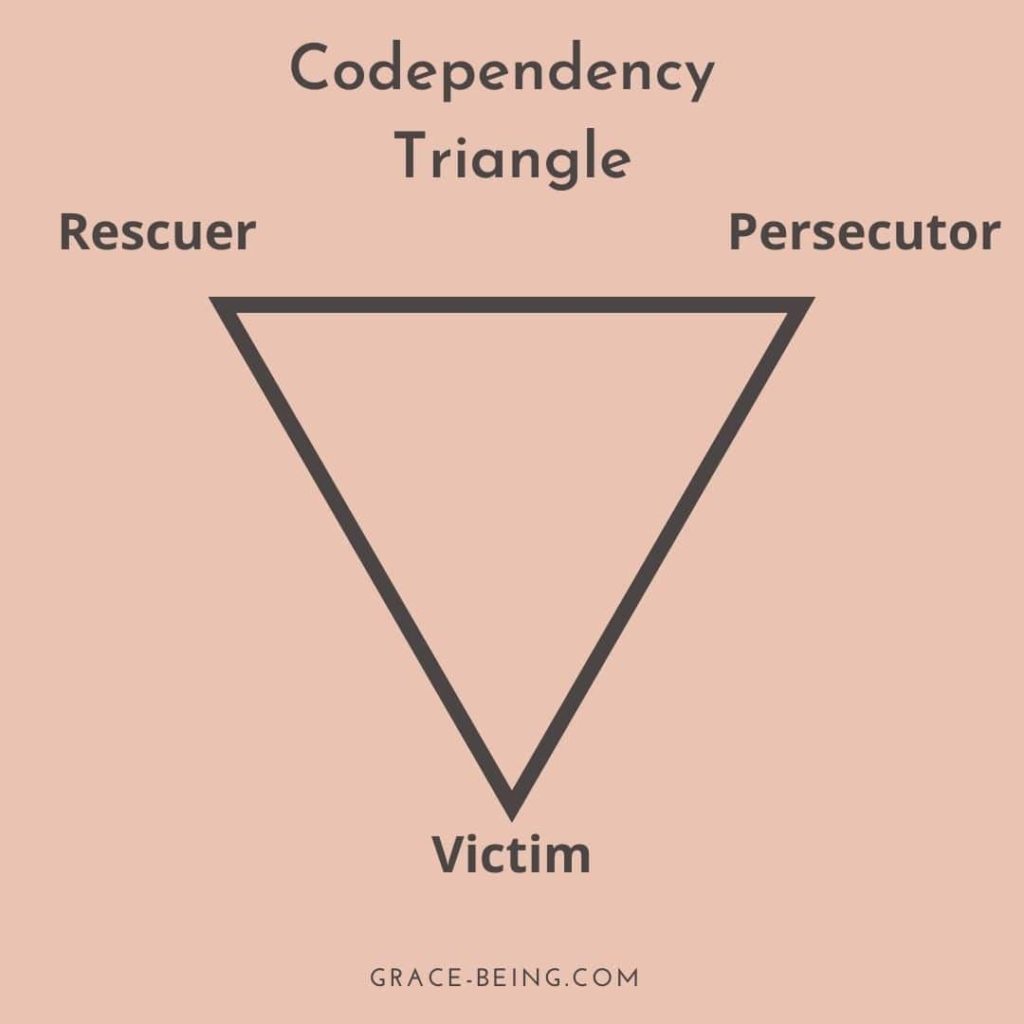Codependency Triangle In Narcissistic Relationships
Have you ever heard of the term codependency triangle?
Do you have a lot of drama in your relationship?
Are you always trying to help others before helping yourself?
If this sounds like you, you might be stuck in a codependency triangle.
A codependency triangle describes the three different roles codependents and narcissists play in a toxic relationship. Narcissists and codependents are two opposites, yet have common dysfunctional behavioral patterns. Both suffer from codependency issues and have patterns of codependency.
Codependents are more likely to end up in relationships with narcissists due to their patterns of codependency. While narcissists target people like codependents to take advantage of their will to help others while neglecting their own needs.
If you’re interested in healing from narcissistic abuse, I warmly welcome you to my Narcissistic Abuse Recovery Program. It’s an easy self-paced online course which you can do at your own pace. My signature program combines scientific and spiritual tools for holistic healing of the body, mind, and spirit.
What is a codependency triangle?

The codependency triangle also known as the Karpman Drama Triangle is a social model of human interaction and toxic behavior in a relationship.
These three roles are played in the codependency triangle:
- Rescuer
- Persecutor
- Victim
Codependents and narcissists shift from these roles depending on the circumstances in their relationship. Lets’ see how these codependency triangle roles come into play in a narcissist and codependent relationship.
The rescuer role
- Rescuer narcissist:
Narcissists are also codependents and they play the rescuer role in the beginning of the relationship. They focus on getting their victims hooked on them by presenting themselves as their ideal partner. Codependents feel like they just found their ‘knight in shining armor’ as a result of love bombing by the narcissist.
- Rescuer codependent:
Codependents consistently play the role of a rescuer in a narcissistic relationship. They want to help fix their partner and save the relationship. If they don’t attend to the narcissists’ needs, they feel guilty and unworthy. The rescuers unconsciously want to perceive themselves as heroes to feel needed and valued.
Related: 12 Traits of a Narcissist
The persecutor role
- Persecutor narcissist:
When narcissists notice that their victims are emotionally dependent on them, they shift to the persecutor role. They start acting like bullies and engage in abusive and manipulative behavior.
Narcissists transition from love bombing to narcissist gaslighting. They start blaming, shaming, controlling and belittling their victims. Most often, they refuse to take any personal responsibility for their actions and insist that everything that goes wrong is their partner’s fault.
- Persecutor codependent:
Codependents eventually feel worn out after countless failed attempts to satisfy the narcissist, experiencing frustration from sacrificing themselves without being appreciated.
In an effort to regain control, they may assume an authoritative role, blaming the narcissist and demanding change. However, codependents often fail to recognize that narcissists lack respect for boundaries and won’t change despite threats or ultimatums.
When learning how to deal with a narcissist, codependents must prioritize their own well-being, set boundaries, and consider seeking professional help to navigate the challenges of the relationship effectively.
Related: What Is A Narcissistic Abuse Cycle?
The victim role
- Victim narcissist:
Narcissists play the victim role to refuse taking responsibility for their actions and behaviors. During an argument, they shift the point of the argument and twist facts, usually blaming the victims of being the abusers. That way narcissists can defend themselves and make their partners feel sorry for them.
This tactic confuses their victims and they end up questioning reality as a result of cognitive dissonance. Narcissists adapt the victim role and portray themselves as helpless so they can blame their codependent partner. The codependent feels sorry for the narcissist and comes to the rescue.
- Victim codependent:
Codependents can get stuck in narcissistic relationships for a very long time. Being subjected to narcissistic abuse has long-term damaging effects and destroys your self-esteem.
Victims of narcissistic abuse feel powerless and hopeless against their situation. They are probably not aware of their patterns of codependency that keep them stuck in this codependency cycle of toxic and destructive behavior.
People who get involved in relationships with narcissists usually form trauma bonding. There is so much going on in the relationship and they are most often unaware of what’s happening. Since they feel powerless against their abuser and are emotionally dependent on them, codependents end up being victims of narcissists for years.
Related article: Behavioral Cycle Of A Narcissist
How to break free from the codependency triangle?
The first step to breaking free from the codependency triangle is to become aware of your patterns of codependency. Then you can start working on yourself to get out of the codependency cycle. Repeating codependency affirmations helps you reprogram your brain to break free from your codependency.
If you are in a narcissist and codependent relationship, it will be more difficult for you to remove yourself from the codependency triangle. Rest assured that no matter how hard you try, the narcissist will suck you back into the toxic cycle.
So ideally, you break up the relationship and distance yourself from your abuser. Doing inner work and healing is crucial at this point. You need to unlearn your behavioral style and adapt a healthy communicative style.
Most importantly is that you work on rebuilding your self-esteem, re-connect with yourself and heal your emotional wounds. That way you learn how to protect yourself from toxic people and learn how to create loving and healthy relationships.
My Related Services:
–Narcissistic Abuse Recovery Program: Join a structured program that provides tools, resources, and guidance to help you navigate and heal from the impact of narcissistic abuse.
–Mindfulness Meditation Practice: Discover the power of mindfulness with me as your meditation teacher. This practice has been a transformative tool in helping me gain mental clarity, rebuild self-trust, and respond consciously rather than reacting impulsively. Book a free call today and learn how mindfulness can calm your nervous system and bring peace into your life.
–Email Advice: Get guidance, insights, and support directly to your inbox.
FAQs
A codependency triangle is a social model describing toxic human behaviors in a relationship. The codependency triangle also known as Karpman drama triangle is described by three roles: Rescuer, Persecutor, Victim.
Both narcissists and codependents get caught in the codependency triangle in relationships. These two opposites have similar dysfunctional behavioral patterns and shift between these roles when they are in a relationship: Rescuer, Persecutor, Victim.
Patterns of codependency the need to fix or save people and feel wanted or needed. Codependents prioritize others’ needs before their own. They do anything to save the relationship and have problems with self-esteem and fear of abandonment.






